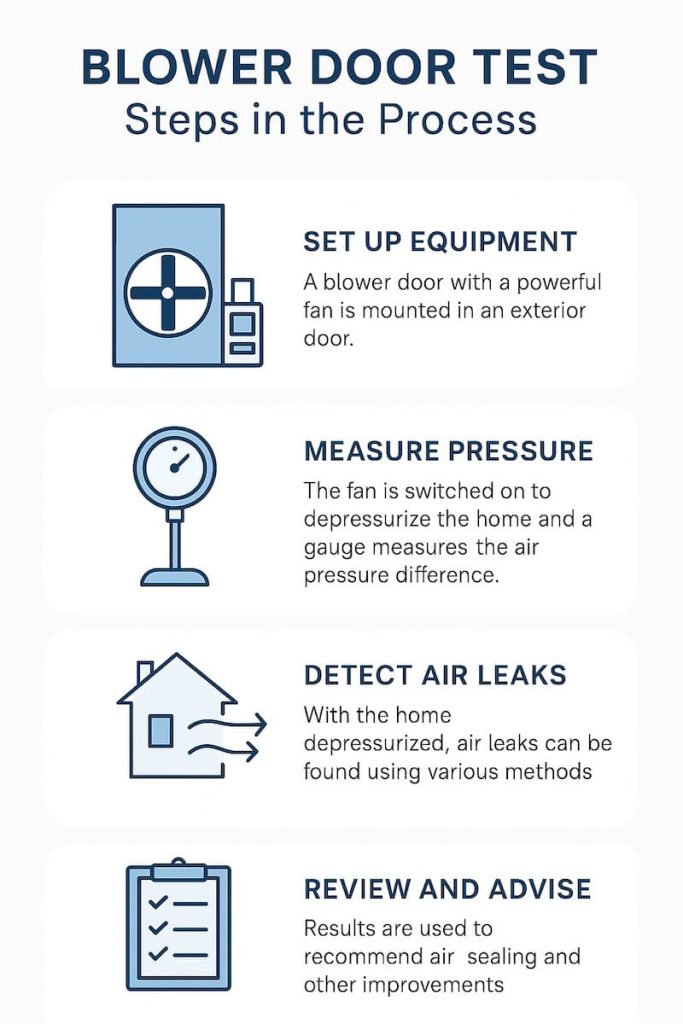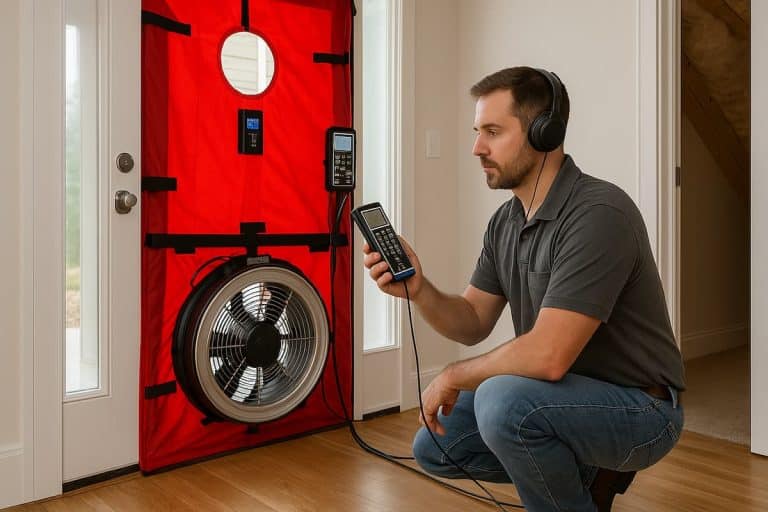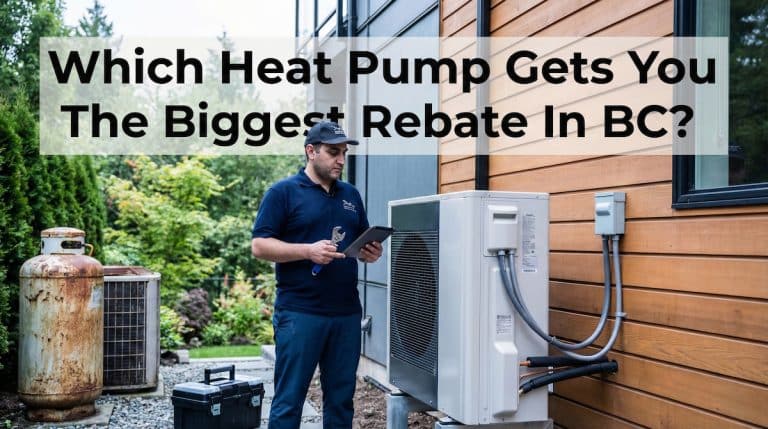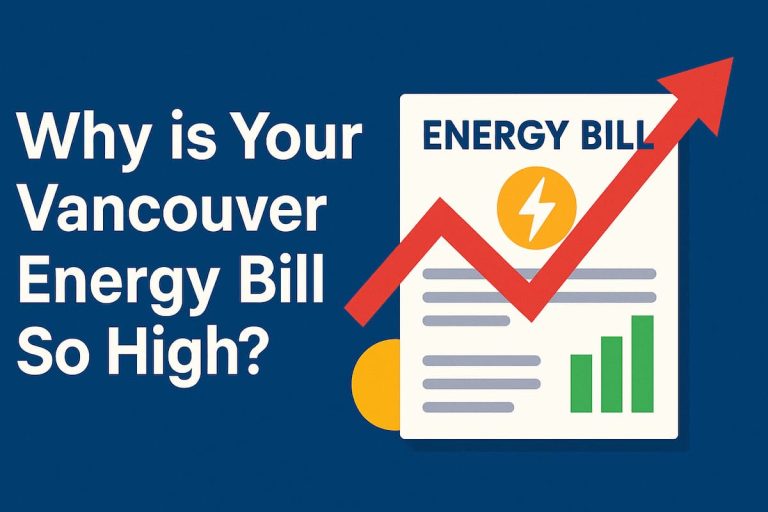Have you ever felt a chilly draft even with the windows closed, or noticed your energy bills creeping up with no clear explanation? The truth is, your home might be leaking energy — silently and invisibly. Fortunately, there’s a smart solution to uncover where the problem lies: a blower door test.
At Monolith Housing Solutions, we help homeowners like you take control of comfort, costs, and energy efficiency. This blog will show you how a blower door test works — and how it can put money back in your pocket 💸.
What Is a Blower Door Test?
A blower door test is a diagnostic tool used to measure how airtight your home is. During the test, a technician temporarily mounts a large fan in your exterior doorway. The fan pulls air out of the home, creating a pressure difference between inside and outside. As outside air rushes in through gaps and cracks, the equipment measures how much air is leaking — and from where.
The result? A detailed snapshot of your home’s air leakage — something you can’t see, but definitely feel.
How Air Leaks Cost You Money
When air escapes through holes in your home’s structure, your HVAC system has to work harder to keep temperatures comfortable. That leads to:
-
Higher heating and cooling bills
-
Increased wear on your furnace or AC
-
Uncomfortable drafts and cold or hot spots
-
Moisture and humidity issues that can affect building health
Even tiny leaks in windows, baseboards, electrical outlets, and attics can add up to big losses — year after year.
What the Test Reveals
The test produces two important numbers:
-
CFM50 (Cubic Feet per Minute): the amount of air leaking at 50 Pascals of pressure.
-
ACH50 (Air Changes per Hour): how often the entire volume of air in your home is replaced at that pressure.
The lower the ACH50, the better your home holds conditioned air. Homes built to code usually fall around 3–5 ACH50, but high-performance homes (like Passive House) aim for less than 1!
What Happens After the Test?
After your test, our team will walk you through the findings. You’ll receive:
-
A report showing where leaks occur
-
Visual clues (like smoke pencil or infrared camera results)
-
Recommended steps to improve airtightness
This might include air sealing around windows, adding attic insulation, or upgrading ventilation for balanced airflow.
Benefits of Airtightness
Improving your home’s airtightness means more than just lower energy bills. You’ll also get:
-
🌡️ More even temperatures throughout your home
-
🛏️ Fewer drafts, for better comfort
-
💨 Cleaner indoor air, with fewer allergens and pollutants
-
🧱 Less risk of mold or moisture damage
And yes — all this adds up to real, long-term savings.
Rebates, Incentives & Long-Term Value
Depending on your region, blower door tests may be part of qualifying for energy retrofit rebates or code compliance. Local utilities or provincial programs often provide:
-
Cash-back incentives for air sealing
-
Grants for efficiency upgrades
-
Support for meeting new building code standards
Ask our team at Monolith Housing Solutions how we can help you qualify.
Ready to Stop Energy Leaks?
If you’re building a new home, renovating, or just tired of paying for wasted energy, it’s time to schedule a blower door test. Our experts will assess your home and recommend practical, cost-effective improvements to make your space more efficient and comfortable.
Contact Monolith Housing Solutions today to book your test or learn more about how we help you save money and live better.

FAQs About Blower Door Testing
-
How long does a blower door test take?
Usually 1–2 hours, depending on the size of your home. -
Is the test safe for my home and HVAC system?
Yes! It’s a standard diagnostic method used worldwide and won’t damage your home or equipment. -
Will I feel the air during the test?
You might feel drafts near leaks, which is actually helpful for identifying problem spots. -
What is a good ACH50 score?
Below 5 is considered acceptable for many homes. Passive homes aim for under 1. -
Can I prepare my home before the test?
Yes — close all windows and doors, turn off fans and fireplaces, and secure pets. -
How much does a blower door test cost?
It varies, but typically ranges from $250 to $500. Bundled energy audits may reduce the cost. -
Can I do anything myself after the test?
Absolutely. Many air sealing tasks like weather-stripping and caulking are DIY-friendly. -
Do I need a blower door test if I’m building a new home?
In many areas, yes — it’s required to pass energy code and qualify for rebates. -
Will a blower door test find insulation problems too?
Not directly, but it may highlight problem areas that suggest poor insulation. -
Can it help with indoor air quality?
Yes — tighter homes reduce unfiltered air entry, making mechanical ventilation more effective.




